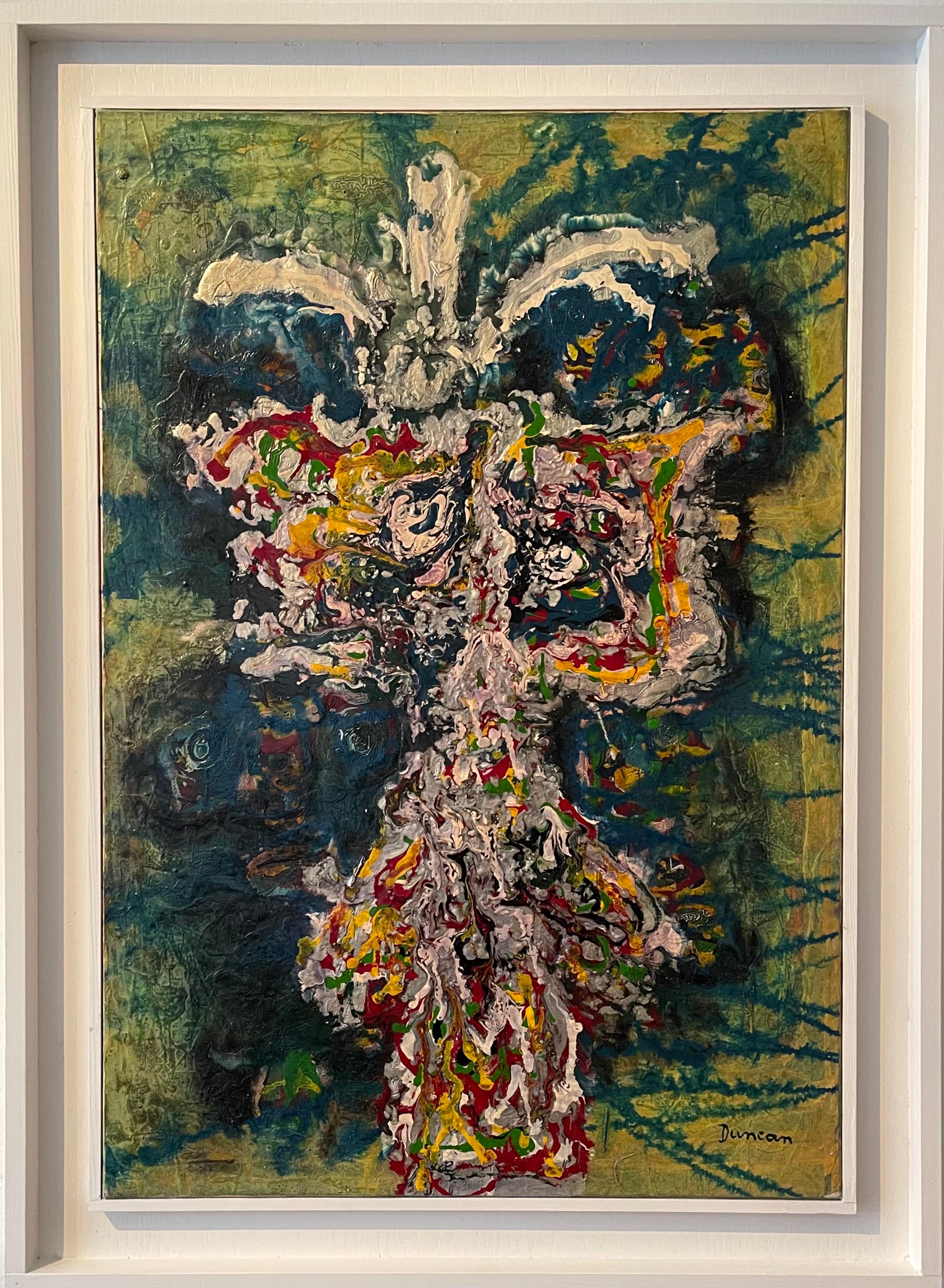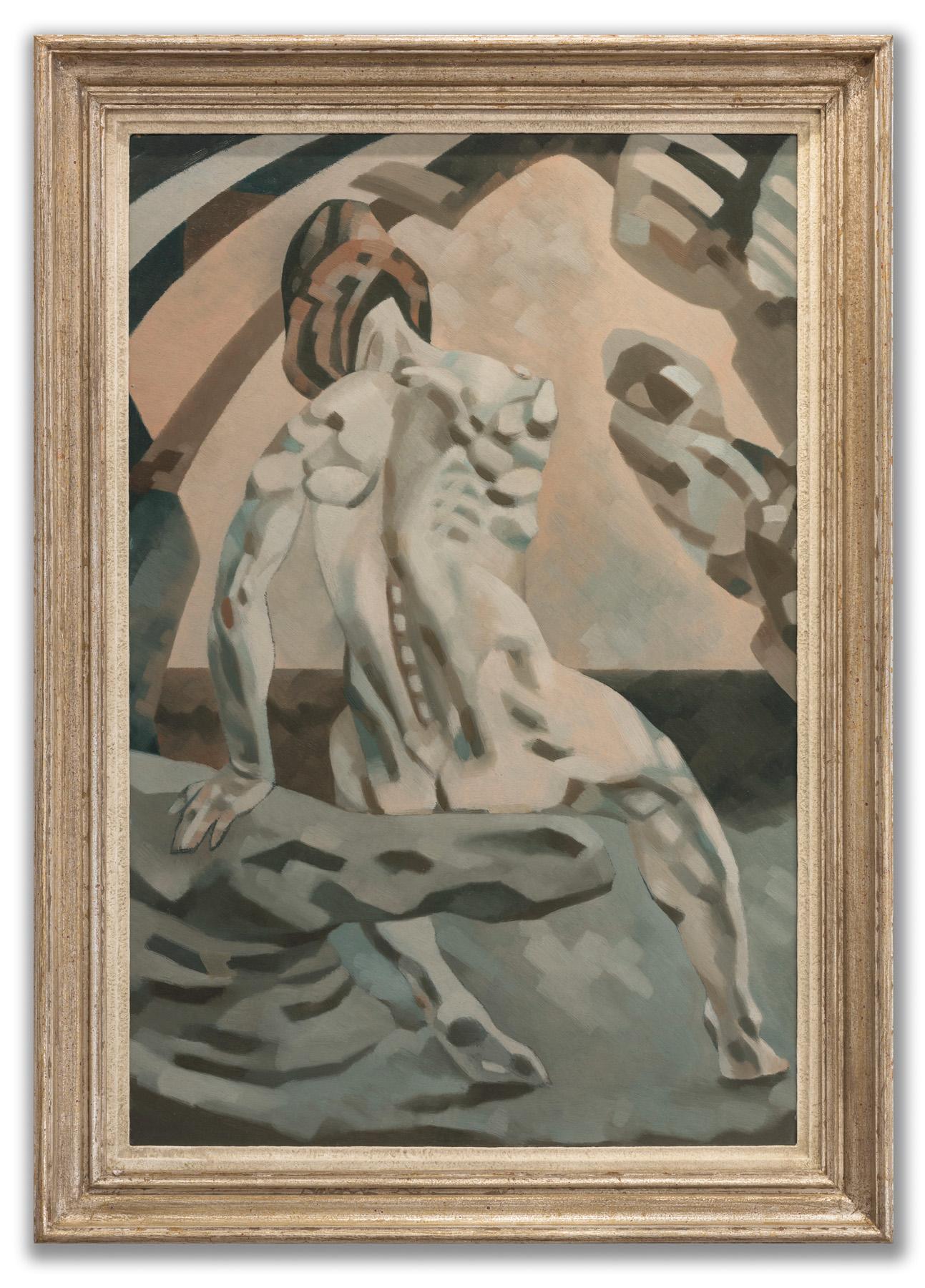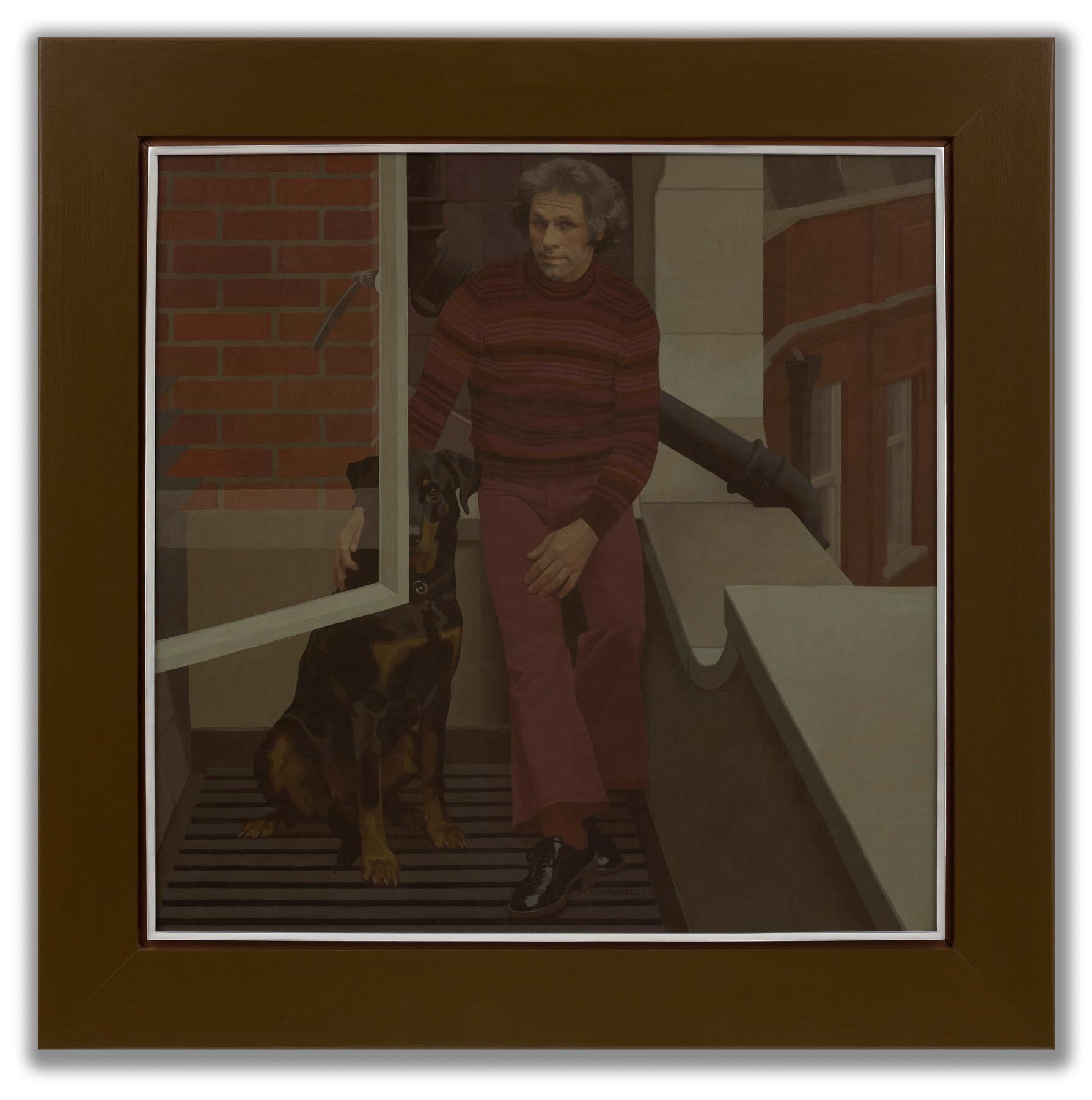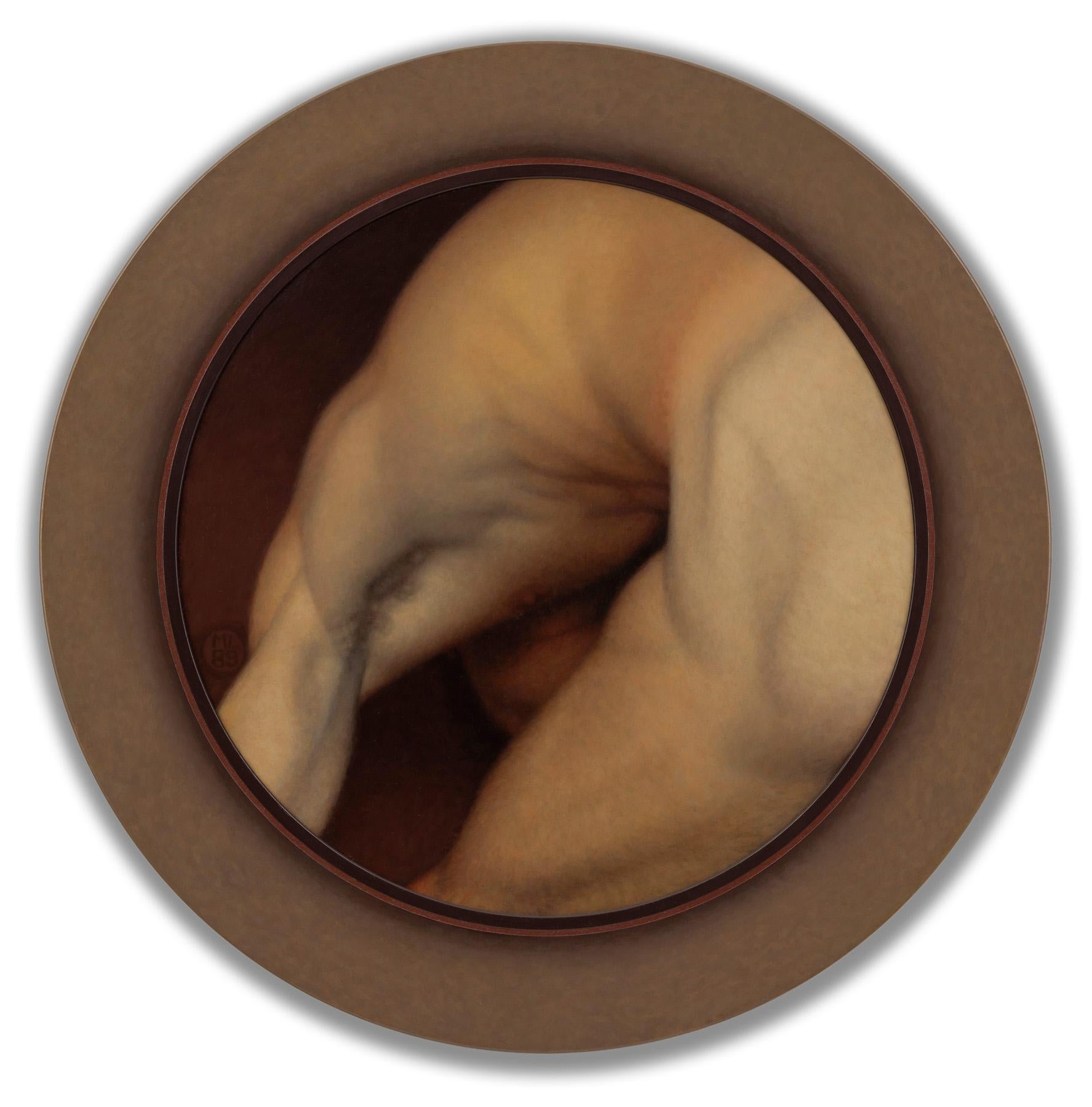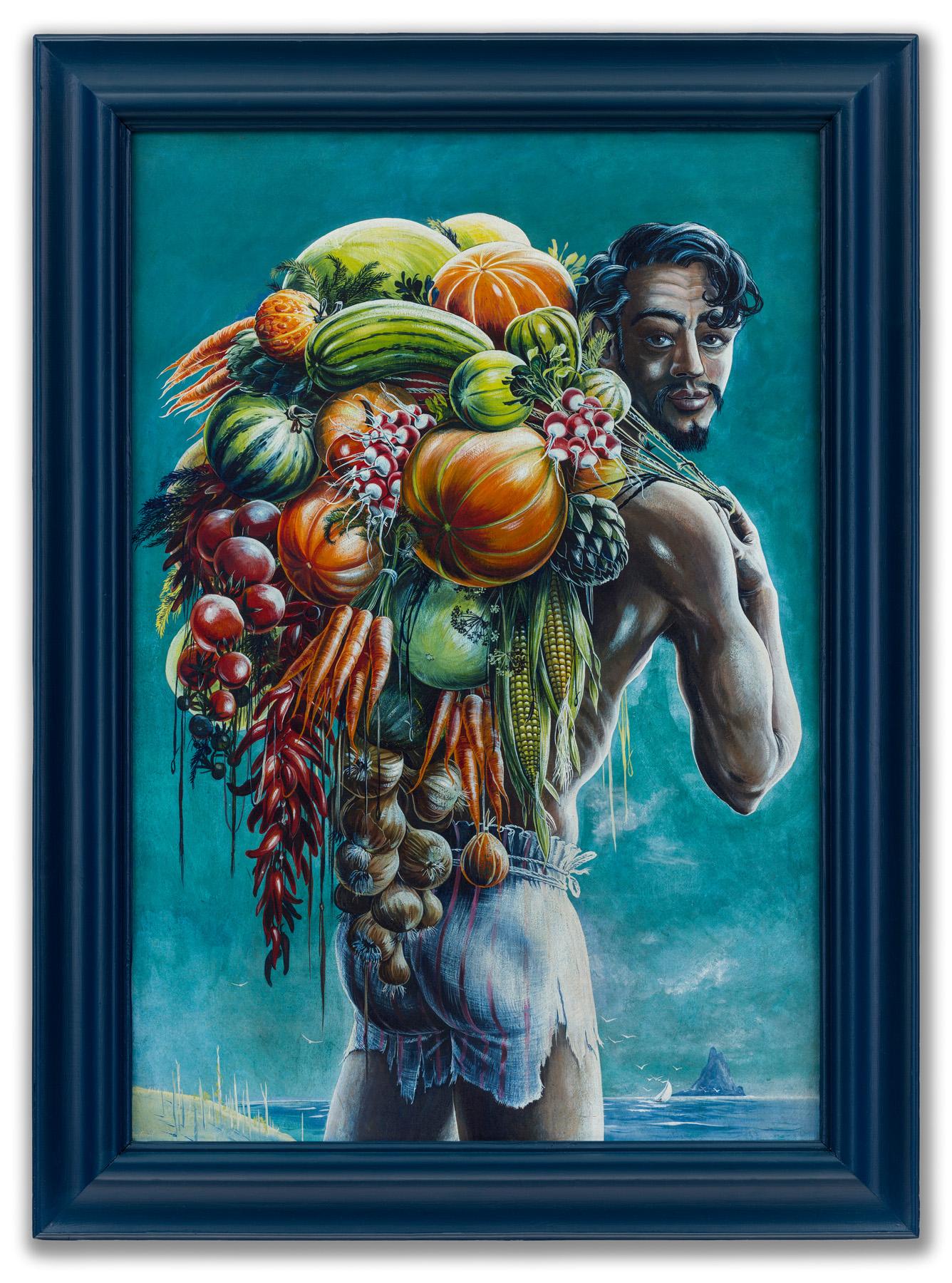Items Similar to White Mask on Violet Ground - Mythic mask mountain -
Want more images or videos?
Request additional images or videos from the seller
1 of 11
Herrmann SchütteWhite Mask on Violet Ground - Mythic mask mountain - 1962
1962
About the Item
Hermann Schütte (1893 Osnabrück - 1973 Hamburg), White Mask on Violet Ground. Enameled copper plate on wooden base, 37 x 29.5 cm, monogrammed and dated "S[chütte] [19]62" in the lower right corner of the fire, inscribed on the reverse (by another hand?) with "Hermann Schütte", titled as "Mask" and dated "1962".
- upper corner slightly creased, otherwise very good condition
- Mythic mask mountain -
About the artwork
In his late work, Hermann Schütte discovered the enamel technique for his artistic work, thus establishing a genre between painting and sculpture, which at the same time has something architectural about it through the wall-like structure of the background. But because the 'stone offset' runs vertically, the 'wall' is a 'surreal wall'. It is this fantastic dimension that feeds the mysterious effect of the work. The Prussian blue background is related to the unfathomable depth of Yves Klein's blue. The pronounced craquelé created by the firing also gives the blue an organic vibrancy. It seems to have contracted by itself. The resulting cracks reveal the reddish-brown copper underneath, giving the blue a deep ground on which it seems to 'float'.
Above the moving, vibrant blue ground, which nevertheless appears solid because of the stone-like structure, is a mountain-like formation with two eye slits and a nose, revealing itself - as the title suggests - to be a mask. However, this is not a mask that can be put on, it has a life of its own and is thus in the tradition of medieval leaf masks, the most prominent example of which can be seen on the pedestal of the Bamberg Rider (around 1230).
Shaped like a mountain and equipped with its own nose, the mask also displays its own organic liveliness through the gray surfaces, which are also vertically aligned and seem to have grown, which is further intensified by the sand-like ghostly structure of the white surfaces. The fact that the eye openings remain black and thus blind, yet appear deeper in color than the blue, adds to the mysterious dimension of this enigmatic creature.
The white "mountain mask" and the blue ground create a pattern-ground relationship that is ornamentally enlivened by the craquelure. The vibrant blue ground, reminiscent of Babylonian tiles, and the anthropomorphic mountain mask unfold an archaic, fairy-tale dimension that lends depth to the mysterious and at the same time spreads as a surface sheen.
With the yellow monogramand the year in complementary contrast to the blue, the artist inscribes himself in this mystery.
About the artist
Hermann Schütte grew up in the era of the avant-garde and, like so many artists, volunteered for World War I, only to return home a convinced pacifist after the horrors he had witnessed. Inspired by literary expressionism, he wrote the book "Mensch! God! Ich!". Its cover was illustrated by the spiritus rector of the Worpswede artists' colony, Heinrich Vogeler. After becoming friends with Kurt Schwitters, Schütte created sculptures and installations in the spirit of the Dada movement initiated by Schwitters. During the Nazi era, Schütte withdrew into inner emigration, only to return to intense artistic activity after the Second World War.
Since 1948, Schütte has participated in numerous exhibitions, including those at the Hamburger Kunsthalle, in Oldenburg, Bremen, Worpswede, Witten, Bad Soden, Düsseldorf, and Osnabrück. In 1967, his hometown of Osnabrück dedicated a large monographic exhibition to him, in which 120 of his works provided an overview of his oeuvre.
Selected Bibliography
Rabe, Hanns-Gerd (Einleitung): Hermann Schütte. Ölgemälde, Emailbilder, Federzeichnungen. Katalog zur Ausstellung vom 29. Oktober bis 3. Dezember 1967, Städtisches Museum Osnabrück, Osnabrück 1967.
GERMAN VERSION
Hermann Schütte (1893 Osnabrück - 1973 Hamburg), Weiße Maske auf violettem Grund. Emaillierte Kupferplatten auf Holzgrund, 37 x 29,5 cm, rechts unten im Brand monogrammiert und datiert „S[chütte] [19]62“, rückseitig (von fremder Hand?) mit „Hermann Schütte“ bezeichnet, als „Maske“ betitelt und mit „1962“ datiert.
- obere Ecke leicht bestoßen, sonst in sehr gutem Zustand
Exposé als PDF
- Mystischer Maskenberg -
zum Kunstwerk
In seinem Spätwerk hat Hermann Schütte die Emailtechnik für sein künstlerisches Schaffen entdeckt und damit eine Gattung zwischen Gemälde und Skulptur etabliert, die durch die mauerverbundartige Struktur des Hintergrundes hier zugleich etwas Architektonisches hat. Indem der ‚Steinversatz‘ aber vertikal verläuft, ist die ‚Mauer‘ eine ‚surreale Mauer‘. Aus eben dieser phantastischen Dimension speist sich die geheimnisvolle Wirkung des Kunstwerks. Der in Preußisch Blau gehaltene Hintergrund weist eine Verwandtschaft mit der unergründlichen Tiefe des Blaus von Yves Klein auf. Durch das beim Brand entstandene ausgeprägte Craquelé gewinnt das Blau zudem eine organische Lebendigkeit. Es hat sich scheinbar von sich aus zusammengezogen. Die dabei entstandenen Risse geben das darunterliegende braunrote Kupfer frei, wodurch dem Blau ein Tiefengrund verliehen wird, auf dem es zu ‚schwimmen‘ scheint.
Über dem bewegt lebendigen blauen Grund, der vermittels der steinversatzartigen Struktur dennoch solide erscheint, ist eine bergartige Formation zu sehen, die zwei Augenschlitze und eine Nase aufweist und sich damit – dem Titel entsprechend – als Maske zu erkennen gibt. Diese Maske ist aber keine Maske, die zum Aufsetzen bereitliegen würde, vielmehr führt auch sie ein Eigenleben und steht damit in der Tradition mittelalterlicher Blattmasken, deren prominentesten Beispiel am Postament des Bamberger Reiter (um 1230) zu sehen ist.
Wie ein Berg ausgebildet und mit einer eigenen Nase versehen, weist auch die Maske durch die ebenfalls vertikal ausgerichteten und wie gewachsen wirkenden grauen Flächen eine eigene organische Lebendigkeit auf, die von der sandartig gespengelten Struktur der weißen Flächen noch intensiviert wird. Dass die Augenöffnungen schwarz bleiben und damit blind sind, farblich aber dennoch tiefer als das Blau wirken, befördert die geheimnisvolle Dimension dieses rätselhaften Wesens.
Die weiße ‚Bergmaske‘ und der blaue Grund schließen sich zu einem Muster-Grund-Verhältnis zusammen, das vom Craquelé ornamental belebt wird. Der an babylonische Fliesen gemahnende, lebendige blaue Grund und die anthropomorphe Bergmaske entfalten eine archaisch-märchenhafte Dimension, die dem Geheimnisvollen ihre Tiefe verleiht und sich zugleich als Oberflächenglanz verbreitet.
Mit dem gelben zum Blau in Komplementärkontrast stehenden Monogramm und der Jahreszahl schreibt sich der Künstler selbst in dieses Geheimnis ein.
zum Künstler
Hermann Schütte wuchs in die Zeit der Avantgarden hinein und meldete sich – wie so viele Künstler – freiwillig zum ersten Weltkrieg, um nach den durchlebten Schrecken als überzeugter Pazifist heimzukehren. Vom literarischen Expressionismus erfasst, schrieb er 1919 das Buch "Mensch! Gott! Ich!", dessen Umschlag der Spiritus rector der Künstlerkolonie Worpswede, Heinrich Vogeler, illustrierte. Nachdem Schütte mit Kurt Schwitters in freundschaftlichen Kontakt getreten war, schuf er Plastiken und Installationen im Geiste der von Schwitters initiierten Dada-Bewegung. Während der Zeit des Nationalsozialismus zog sich Schütte in die innere Emigration zurück, um nach dem zweiten Weltkrieg wieder intensiv künstlerisch tätig zu werden.
Seit 1948 nahm Schütte an einer Vielzahl von Ausstellungen teil, u.a. in der Hamburger Kunsthalle, in Oldenburg, Bremen, Worpswede, Witten, Bad Soden, Düsseldorf und Osnabrück. 1967 widmete ihm seine Vaterstadt Osnabrück eine große monographische Ausstellung, auf der 120 seiner Werke eine Übersicht über sein Schaffen vermittelten.
Auswahlbibliographie
Rabe, Hanns-Gerd (Einleitung): Hermann Schütte. Ölgemälde, Emailbilder, Federzeichnungen. Katalog zur Ausstellung vom 29. Oktober bis 3. Dezember 1967, Städtisches Museum Osnabrück, Osnabrück 1967.
- Creator:Herrmann Schütte (1893 - 1973, German)
- Creation Year:1962
- Dimensions:Height: 14.57 in (37 cm)Width: 11.82 in (30 cm)Depth: 0.79 in (2 cm)
- Medium:
- Movement & Style:
- Period:
- Condition:
- Gallery Location:Berlin, DE
- Reference Number:1stDibs: LU2438212355472

About the Seller
5.0
Vetted Seller
These experienced sellers undergo a comprehensive evaluation by our team of in-house experts.
Established in 2014
1stDibs seller since 2023
7 sales on 1stDibs
Typical response time: 6 hours
- ShippingRetrieving quote...Ships From: Berlin, Germany
- Return PolicyA return for this item may be initiated within 14 days of delivery.
More From This SellerView All
- Mary Magdalene - Faith transforms inner into outer beauty and conquers death -By Balthasar DennerLocated in Berlin, DEBalthasar Denner (1685 Hamburg - 1749 Rostock). Mary Magdalene. Oil on copper, 37 × 32 cm (visible size), 45 x 40 cm (frame), signed and indistinctly dated "Denner 17(...)" at centre...Category
1720s Old Masters Figurative Paintings
MaterialsCopper
- Small Nude / - Abstract Figurativity -Located in Berlin, DEGustl Stark (1917 Mainz - 2009 ibid.), Small Nude, 1946. Oil on canvas, marouflaged, 54 x 25 cm (picture), 30 x 60 cm (frame), signed "Stark" top left, verso twice signed "Gustav Stark", inscribed by hand as "Small Nude" and dated by hand "1946". With label of the exhibition of the Bundeshaus Bonn from 1956. - Rubbed area in the lower third of the body, at the same level a retouch in the ochre background. I provisional frame. - Abstract Figurativity - About the artwork During the war, Gustl Stark suffered a particularly severe blow for an artist: he lost his right arm. Nevertheless, he continued to devote himself to art, and the painting, created in 1946, immediately after the end of the Nazi reign of terror, testifies to the dawn of a new era. At the same time, the work is a rare example of the artist's early figurative work, as Stark turned entirely to abstract painting as early as 1950. And even this painting is by no means purely figurative; rather, it already illustrates Stark's turn toward abstraction. We see a female nude, but one that remains faceless. This can be read symbolically and in relation to the immediate past epoch, which, in the face of horrors, silences and blinds - literally renders faceless. In this sense, the figure is positioned to 'look back'. But she does not look. While this meaning may resonate and make the painting an important work of the immediate postwar period, Gustl Stark is primarily concerned with something else here, namely art itself. The absence of the face leads to the body becoming something flat. Due to the de-individualization, we do not see a concrete person with his individual features, but a body surface. And indeed, the body is constructed through an extremely planar design. Even the contour lines that form the corporeality have a planar rather than a linear character, especially where they merge into shadow zones of almost the same color. And the surfaces themselves are not modeled. The incarnate parts do not show any plastic gradations; the corporeality is completely withdrawn into the plane, which is also true for the hair. In addition, there is no uniform background against which the figure could appear; rather, the area next to the hair is kept bluish, creating a succession of earth-toned colored areas, which again binds the figure to the surface. Last but not least, the flatness is also forced by the painting technique. Gustl Stark paints directly, a la prima, onto the coarse canvas, whereby the structure of the painting support remains visible in the picture, and in places - around the hair, for example - the canvas itself can be seen. This structural all-over lends the picture a certain flatness. Gustl Stark thus uses the very motif that stands for the corporeality of art par excellence - the female nude - to transform the spatiality of the traditional picture into a flatness characteristic of modern art. And yet, a strong impression of corporeality is created, without being produced by a painterly modeling of the body. The oscillation between flatness and corporeality creates the intense tension of this groundbreaking painting. In Gustl Stark's oeuvre, as a consequence of the abstraction we see here, the figurative is completely stripped away in a further step, which is also a loss when looking at this early key work. About the artist Gustl Stark was the son of a woodcarver and, after an apprenticeship as a decorative painter, attended the State School of Arts and Crafts in Mainz from 1936 to 1937. Although he was severely wounded in the war and lost his right arm, he studied at the Würzburg School of Painting and Drawing from 1943-1944 and then at the Academy of Fine Arts in Nuremberg from 1944-1948. He won a state scholarship at the state art competition in Bad Ischl. Numerous study trips to Sylt, Paris, Switzerland, Austria, Italy, Holland and Belgium followed. Gustl Stark worked in Mainz and was the first artist there to focus on abstract painting. His work quickly gained international recognition, including the Salon Réaliés Nouvelles in Paris. From 1963-1970 he taught at the State University Institute for Art and Work Education in Mainz and from 1970-1975 at the Johannes Gutenberg University. Gustl Stark became particularly famous for his color embossed prints, for which he invented his own technique. Gustl Stark received numerous awards for his work. He received the Art Prize for Painting of the City of Mainz in 1962, the State Prize of Rhineland-Palatinate in 1984, and the Gutenberg Bust of the City of Mainz in 1987. Selected Bibliography Hans Vollmer (Hrsg.): Allgemeines Lexikon der bildenden Künstler des XX. Jahrhunderts, Vierter Band, Leipzig 1958, S. 344. Hans H...Category
1940s Realist Nude Paintings
MaterialsCanvas
- Ballerina in the dressing roomLocated in Berlin, DEKarl Stohner (1894 Mannheim - 1957 Paris), Ballerina in the dressing room, 1924. Pastel on painting cardboard, 65 x 45 cm, 77,5 x 59,5 (frame), signed lower left "Stohner" and dated "[19]24". Behind glass in gold stucco frame of the time. - Painting cardboard slightly warped, in the lower area minimally stained, frame with age patina and traces of abrasion. - The Naturalness of Artificiality - We see a ballerina putting on her right ballet shoe while the left one is still lying on the floor in front of her. It is precisely the casualness of the scene that gives it its intimacy: the blonde young woman is completely absorbed in the activity of getting ready for the dance, oblivious to us, while we are positioned right in front of her in the dressing room, inaccessible to the audience, watching her dress. Even though she does not yet perform a dance step, there is a graceful elegance in the action shown that seems quite natural in contrast to the rehearsed art form of dance. The young woman is not presenting herself to an audience in a perfectly formed movement, but is performing an everyday action, unaware that she is being watched. Concentrated, almost devotional, she pulls the ballet slipper over the verses, not noticing that one of the straps of the tutu has slipped off her shoulder, reinforcing the erotic moment of the scene. Inspired by Edgar Degas, Karl Stohner has painted the scene in strong pastel tones. The dominant blues and turquoises give the scene a magical, mysterious quality and, like the pink of the stockings and ballet slippers, are borrowed from Degas's dancers. Degas's colors, however, are cooler tempered, which is particularly evident in the light impasto applied incarnate. This is where the vividness of Auguste Renoir comes into play, making the dancer seem entirely flesh and blood. Karl Stohner, who has studied the pastels of Degas and Renoir intensively, combines the two artists here to create his own pictorial language. He has laid out the background in broad layers of strokes, ranging in color from white to turquoise to dark blue. The result is a dynamic, pattern-like structure that contrasts with the woman's calm, inward-looking posture. The fund anticipates the dynamics of the choreography of the dance for which the ballerina is preparing. At the same time, the broad pastel line in the background is an adequate means of painting to depict the soft, flowing elegance of the dancer. About the artist Against the wishes of his wealthy parents, Karl Stohner decided to become a painter. His talent was discovered by the director of the Mannheim Art Gallery, Fritz Wichert, who supported him from then on, including financing study trips to Paris. There he discovered the art of Degas, Cézanne and Renoir, which inspired his work. GERMAN VERSION Karl Stohner (1894 Mannheim - 1957 Paris), Ballerina im Ankleideraum, 1924. Pastell auf Malkarton, 65 x 45 cm, 77,5 x 59,5 (Rahmen), unten links mit „Stohner“ signiert und auf „[19]24“ datiert. Hinter Glas im Goldstuckrahmen der Zeit. - Malkarton leicht verzogen, im unteren Bereich minimal fleckig, Rahmen mit Alterspatina und Abriebspuren - Die Natürlichkeit der Kunstform - Wir sehen eine Ballerina, die sich den rechten Ballettschuh anzieht, während der linke noch vor ihr auf dem Boden liegt. Gerade aus der Beiläufigkeit der Szenerie speist sich ihre Intimität: Die blonde...Category
1920s Post-Impressionist Figurative Paintings
MaterialsPastel
- The gift of flowersBy Conrad KieselLocated in Berlin, DEConrad Kiesel (1846-1921), The gift of flowers. Oil on wood, 43 x 35 cm, 69 x 61 cm (frame), signed at lower left "Conrad Kiesel pxt [pinxit]", about 1900. In a magnificent gilt stuc...Category
1890s Academic Nude Paintings
MaterialsOil
- Landscape with Trees by a Lake - Eternal summer silence over an abysmal lake -Located in Berlin, DEAndreas Thomas Juuel (1816 Copenhagen - 1868 Copenhagen). Summer landscape with tall deciduous trees by a lake. Oil on canvas, 54,5 x 42 cm (visible size), 71 x 58 cm (frame), signed...Category
1850s Realist Landscape Paintings
MaterialsOil
- Autumn Landscape in Sunlight - Indian Summer -Located in Berlin, DEFrederick Vezin (1859 Torresdale Philadelphia - 1933 Düsseldorf), Autumn Landscape in the Sunlight, oil on canvas, mounted on cardboard, 32 x 41 cm (inside measurement), 44 x 51 cm (...Category
Early 1900s Impressionist Landscape Paintings
MaterialsOil, Cardboard
You May Also Like
- Black FlowersBy Donald SultanLocated in Palm Desert, CAA painting by Donald Sultan. "Black Flowers: is a flock, enamel, and spackle on tile over masonite executed in a dark palette of black, reds, and grays an...Category
Early 2000s Post-War Figurative Paintings
MaterialsEnamel
- "Owl by Night" A Post-War Expressionistic Oil Painting by British Joseph DuncanLocated in Frederiksberg C, DKIntroducing a beautifully gripping post-war oil painting by British artist Joseph Duncan. Within this intense expressionistic work, the powerful use of c...Category
1960s Post-War Abstract Paintings
MaterialsOil, Canvas
- Figure in a LanscapeBy Francis PlummerLocated in London, GBOil on board, 62cm x 42cm, (70cm x 50cm framed). The picture is in good condition. Plummer trained at the Royal Academy Schools in the early 1950s, championed by Stanley Spencer and Sir Herbert Read, he was the recipient of the coveted Leverhulme Scholarship. In a mixed career which included illustration work for The National Trust, anatomical illustration for Guys Hospital and teaching, painting ran parallel to his commercial work. Plummer specialised in the medium of egg tempera, as well as oil painting, a technique little used since the frescos of the Renaissance, he often worked on a large scale, but in tremendous detail, combining Classical iconography and formal composition with visual exploration evocative of William Blake and...Category
1980s Post-War Figurative Paintings
MaterialsOil, Board
- Alan, Bella, Brick and SlateBy Michael LeonardLocated in London, GBAcrylic on Masonite board, signed and dated (lower middle), 70cm x 70cm (91cm x 91cm framed). Price on request This work depicts Alan and his dog, Bella, on Michael Leonard’s balcon...Category
1970s Post-War Figurative Paintings
MaterialsAcrylic, Board
- Man Reaching Down: TondoBy Michael LeonardLocated in London, GBAlkyd-oil on Masonite, signed and dated (middle left), 61cm (diam.), (83cm diam. framed). (This work was kept by the artist for his personal collection. It remained in his collection...Category
1980s Post-War Figurative Paintings
MaterialsOil, Board
- The Vegetable Seller, MauritiusBy Stuart Maxwell ArmfieldLocated in London, GBTempera on board, 87cm x 60cm (framed 106cm x 78cm). Stuart Maxwell Armfield (1916-2000) was renowned for his use of the traditional egg tempera technique, a skilled process that us...Category
1940s Post-War Nude Paintings
MaterialsEgg Tempera, Board

